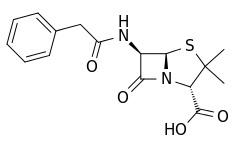Benzylpenicillin
 | |
|
Penicillin G | |
| Systematic (IUPAC) name | |
|---|---|
|
(2S,5R,6R)-3,3-dimethyl-7-oxo-6-(2-phenylacetamido)-4-thia-1-azabicyclo[3.2.0]heptane-2-carboxylic acid | |
| Clinical data | |
| Trade names | BenPen |
| AHFS/Drugs.com | Micromedex Detailed Consumer Information |
| MedlinePlus | a685013 |
| Pregnancy category | |
| Legal status |
|
| Routes of administration | Intravenous, Intramuscular, formerly used orally |
| Pharmacokinetic data | |
| Protein binding | 60 % |
| Metabolism | hepatic |
| Biological half-life | 30 min |
| Excretion | renal |
| Identifiers | |
| CAS Number |
61-33-6 69-57-8 (sodium salt) |
| ATC code | J01CE01 S01AA14 QJ51CE01 |
| PubChem | CID 5904 |
| IUPHAR/BPS | 4796 |
| DrugBank |
DB01053 |
| ChemSpider |
5693 |
| UNII |
Q42T66VG0C |
| KEGG |
D02336 |
| ChEBI |
CHEBI:18208 |
| ChEMBL |
CHEMBL29 |
| Chemical data | |
| Formula | C16H18N2O4S |
| Molar mass | 334.4 g/mol |
| |
| |
| | |
.jpg)
Benzylpenicillin (INN, AAN, BAN), also known as penicillin G, (USAN) is a narrow spectrum penicillin antibiotic that is given intravenously or intramuscularly as a treatment for syphilis, meningitis, endocarditis, pneumonia, lung abscesses and septicaemia in children.[1] Penicillin G is typically given by injection parenterally, bypassing the intestines, because it is unstable in the highly acidic stomach. Because the drug is given parenterally, higher tissue concentrations of penicillin G can be achieved than is possible with phenoxymethylpenicillin. These higher concentrations translate to increased antibacterial activity.
It is on the World Health Organization's List of Essential Medicines, a list of the most important medications needed in a basic health system.[2]
Medical uses
Specific indications for benzylpenicillin include:[3]
- Cellulitis
- Infective endocarditis
- Meningitis
- Aspiration pneumonia, lung abscess
- Community-acquired pneumonia
- Syphilis
- Septicemia in children
- Septic Arthritis
- Gangrene
- Diphtheria
Antimicrobial potency
As an antibiotic, Penicillin G is noted to possess effectiveness mainly against Gram-positive organisms. Some Gram-negative organisms such as Neisseria gonorrhoeae and Neisseria meningitidis are also reported to be susceptible to Penicillin G.[4]
Adverse effects
Adverse effects can include hypersensitivity reactions including urticaria, fever, joint pains, rashes, angioedema, anaphylaxis, serum sickness-like reaction. Rarely CNS toxicity including convulsions (especially with high doses or in severe renal impairment), interstitial nephritis, haemolytic anaemia, leucopenia, thrombocytopenia, and coagulation disorders. Also reported diarrhoea (including antibiotic-associated colitis).
Benzylpenicillin serum concentrations can be monitored either by traditional microbiological assay or by more modern chromatographic techniques. Such measurements can be useful to avoid central nervous system toxicity in any person receiving large doses of the drug on a chronic basis, but they are especially relevant to patients with renal failure, who may accumulate the drug due to reduced urinary excretion rates.[5][6]
Compendial status
References
- ↑ Rossi, S, ed. (2013). Australian Medicines Handbook (2013 ed.). Adelaide: The Australian Medicines Handbook Unit Trust. ISBN 978-0-9805790-9-3.
- ↑ "WHO Model List of Essential Medicines" (PDF). World Health Organization. October 2013. Retrieved 22 April 2014.
- ↑ Rossi S, editor, ed. (2006). Australian Medicines Handbook. Adelaide: Australian Medicines Handbook. ISBN 0-9757919-2-3.
- ↑ "Penicillin G" (pdf). Toku-E. 2010-10-10. Retrieved 2012-06-11.
- ↑ Fossieck B Jr, Parker RH. Neurotoxicity during intravenous infusion of penicillin. A review. J. Clin. Pharmacol. 14: 504- 512, 1974.
- ↑ R. Baselt, Disposition of Toxic Drugs and Chemicals in Man, 8th edition, Biomedical Publications, Foster City, CA, 2008, pp. 1195-1196.
- ↑ British Pharmacopoeia Commission Secretariat. "Index (BP 2009)" (PDF). Retrieved 26 March 2010.
| ||||||||||||||||||||||||||||||||||||||||||||||||||||||||||||||||||||||||||||||||||||||||||||||||
